Why Focus on Cultural Sensitivity and Inclusivity in Video-Based Learning? [Infographic]
In video-based learning, it’s important to focus on cultural sensitivity and inclusivity for effective training outcome. Read on to know in detail.

In the world of cinema, there's a magical moment when the audience connects with a film not just as a visual spectacle but as a shared experience woven into the fabric of their cultural identity. Something as simple as the greeting “Namaste”, “Ciao”, “Bonjour” can evoke a sense of nostalgia and recognition. These cultural references transcend borders and generation.
Much like the way a film quote can bridge gaps and foster a sense of camaraderie, incorporating cultural references into corporate training and eLearning courses holds the potential to create a powerful sense of belongingness among learners. By infusing your eLearning content with familiar cultural touchpoints, whether it's shared values, traditions, or even popular culture phenomena, you can tap into a universal language that resonates with diverse audiences.
In this blog, we will get to know about the benefits of video-based learning, the importance of cultural sensitivity and inclusivity in video-based learning, and 6 considerations to keep in mind. So without any delay, let’s begin!
Top 5 Benefits of Video-Based Learning
- Enhanced Engagement and Motivation
- Personalized Learning Experience
- Improved Knowledge Retention
- Accessibility for Diverse Learners
- Cost-Effectiveness and Scalability
→ Download Now: How L&D And Business Can Align to Conquer The Future Of Work
Importance of Cultural Sensitivity and Inclusivity in Video-Based Learning
Fosters a Welcoming and Inclusive Learning Environment
For a video-based learning to be truly effective, it must be able to captivate learners attention and connect with them. This can be done by paying attention to culturally sensitive aspects and reflecting diverse perspectives. It will ensure that the learners from various cultural backgrounds feel welcomed and represented. Cultural inclusivity promotes a positive and enriching learning experience.
Ensures Relevance and Applicability
Presenting simply anything in video format doesn’t really cut it for high-impact, immersive corporate training. Your video-based learning content should resonate with learners from different cultural backgrounds. Therefore, it is important that you tailor the course material in a manner that is relevant and applicable.
Promotes Cross-Cultural Understanding
Including the cultural aspects in your training courses correctly not only helps you foster belongingness among diverse workforce, it also enables cross-cultural learning. Learners from different cultural backgrounds get to understand about other cultures and become more open and respectful of it. This way, cultural sensitivity and inclusivity in video-based learning has the potential to foster empathy and appreciation for diverse cultures and promote a more interconnected global community.
Addresses Cultural Misrepresentation and Stereotypes
“ A little learning is a dangerous thing.” This quote by Alexander Pope serves as a perfect reminder that it’s better to know nothing at all than knowing bits and pieces of something. But sadly, today’s world is replete with incomplete, one-sided narratives. By following cultural sensitivity and inclusivity in your video-based learning lessons, you can take the initiative to curtail this problem.
It can go a long way in avoiding the perpetuation of harmful stereotypes and misrepresentations. Furthermore, instructional designers must be extra conscious while designing courses for diverse workforces to ensure that the narratives celebrate diversity and avoid reinforcing negative cultural biases.
Enhances Global Competence
By incorporating cultural sensitivity into video-based learning, your learners can better prepare themselves for effective cross-cultural interactions. This is a great benefit for organizations to enhance their global competence.
Cultural Sensitivity and Inclusivity in Video-Based Learning
To Sum It Up!
While video-based learning holds immense potential to take your corporate training initiatives to the next level, you’d still miss the mark if you don’t pay attention to cultural sensitivity and inclusivity. Especially with Millenials and Gen Z becoming an active part of workforce, ensuring diversity, equity, and inclusion (DEI) in your workplace and in the training materials is a must. Learn to make the most of your L&D initiatives by aligning them with your business goals for successful results. Check out the eBook below!







